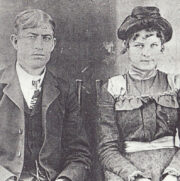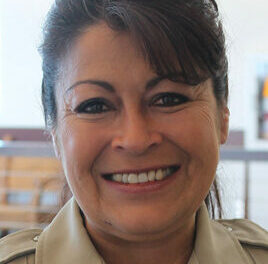While it’s unknown if longtime Fred Harvey Company employee George Clark ever visited the Belen location, part of his legacy now resides within the Belen Harvey House Museum.
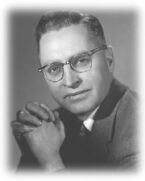
George Clark worked for the Fred Harvey Company for 45 years, retiring in 1975.
Photos courtesy of the Belen Harvey House Museum
Much of his memorabilia — photos, documents and keepsakes — were donated by Clark’s nephew, Carl Rudolph, after visiting the Hub City’s historic building.
“A few years ago, a fellow came in and took a tour of the Harvey House, and it just so happened that I was giving tours that day,” said museum coordinator Frances Zeller. “He started talking to me and said his uncle had worked for the Fred Harvey Company.”
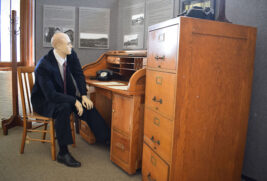
An exhibit at the Belen Harvey House Museum is dedicated to the life’s work of George Clark, who retired as vice president of the Fred Harvey Company. The exhibit can be viewed online at harveyhousemuseum.org/george-clark-panels.
Clara Garcia | News-Bulletin photo
It was an honor for Zeller to give Rudolph the tour, saying it’s always a pleasant surprise when a relative of someone who worked for the company visits, or “Fred Heads,” who are fascinated with the history of the buildings and the people who worked in them.
As the two continued to talk, the museum coordinator learned Rudolph had a lot of his uncle’s mementos — many items the average person might have thrown away. Zeller said. Rudolph asked if she was interested in displaying his uncle’s items at the museum, and without hesitation, she said yes.
“I think anyone who donates a collection to a museum wants to make sure they are worthy of it, and it’s not just going to be thrown in the trash,” Zeller said.
A few months later, Rudolph, who lives in California, sent Zeller a CD with a catalogue of pictures of all that he had. He made the trip back to Belen two years ago to drop off the collection.
With an array of information and artifacts provided to her, and researching Clark’s life on her own, Zeller created an exhibit — both online and at the museum — portraying Clark’s life and legacy in the Fred Harvey Company.
One of the more special items in the collection is a Blue Corn pottery made by Crucita Gonzales Calabaza of the San Ildefonso Pueblo. Clark was given the special gift upon his retirement from the company.
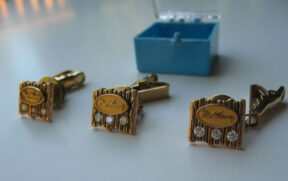
George Clark’s nephew, Carl Rudolph, donated his uncle’s company tie tacks to the Belen Harvey House Museum.
“We received service pins,” Zeller said. “They are tiny, gold and one even has diamonds on it. They were something that employees would treasure.”
George Clark was born in August 1911 in Vaughn, N.M. When he was young, he lived with his family on an old homestead in Puerto, N.M., south of Tucumcari. The home had dirt floors and burlap bags covering the windows. It was a hard life, but they persevered.
Clark graduated from high school in Las Vegas, N.M., and was soon employed at the Fred Harvey Eating House (Gran Quivera) in Clovis. He started his career with the company printing menus in the basement, a trade he learned from his father.
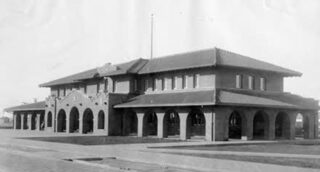
George Clark began his career at the Fred Harvey Eating House (Gran Quivera) in Clovis. He printed menus in the basement.
While working for the company, he took accounting classes through a correspondence school to acquire his CPA license. In 1934, he was promoted to cashier.
“As they slowly got him into the company doing those sorts of accounting things and bookkeeping, he thrived,” Zeller said.
Clark was able to demonstrate his highly-valuable skill sets, and was reassigned to the general offices in Chicago in 1938, when he met and married his wife, June Eversole.
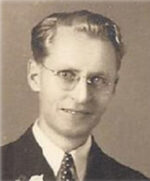
George Clark rose through the ranks of the Fred Harvey Company.
By 1947, Clark was the general auditor of the Fred Harvey Co., and sometime before 1955, he became treasurer. In 1958, he was promoted to controller of the entire company, and then promoted to assistant vice president. In 1968, he was elected vice president.
During his time with the company, Clark traveled to visit many Harvey Houses, but because the Belen location closed in 1939, there is no record Zeller could find that indicated he ever traveled to the Hub City.
Throughout the countless hours of researching his life, Zeller says she felt as she got to know George Clark — a man she describes as having a kind soul.
“He was a religious man. He was the kind of person that you would just respect,” she said of Clark. “He was probably a man of few words — a thinker.
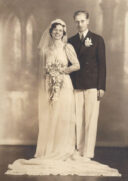
In 1938, George Clark married June Eversole in Chicago. She passed away in 1998, and he died in 2002 at 90 years of age.
“He was very involved in his church and he was a mentor. He worked with the youth and missionaries, and he gave most all of his disposable income to support youth programs and missionaries at his church.”
Clark and his wife never had children of their own, but he gave most of his estate to the Moody Bible Institute. He even gave one of the students an investment in the company.
“It just says volumes about the man, and that kind of tells you about the Fred Harvey Company,” Zeller said. “Everybody really was wholesome and it really had a family-feel to it, so much so that he didn’t want to do the accounting for the liquor sales because of his past and the problems with his father. The company was OK with that. He was valuable enough as an employee that they allowed it.”
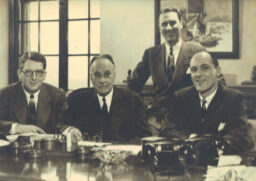
A photo of the Harvey family hung in George Clark’s office for many years. Pictured, from left, are Stewart Harvey, Byron Harvey Sr., Daggett Harvey and Byron Harvey Jr.
Zeller said Clark respected the company and they respected him.
The Fred Harvey Company became part of Amfac in 1968. Two years later, the offices were moved to California, where Clark and his wife moved to as well. He remained vice-president and treasurer until his retirement in 1975.
“He stayed with the company for 45 years,” Zeller said. “Who does that anymore?”
After Clark’s retirement, Ron Barr, who was president of the Fred Harvey Company, presented him with two gifts — a Hawaiian vacation for him and his wife, and the Blue Corn pottery bowl.
Clark and his wife retired to Scottsdale, Ariz., where they lived until June passed away in 1998. He then moved to Oklahoma to be near his sister. He died at the age of 90 years old on April 3, 2002.
The collection donated by Clark’s nephew will remain on permanent display at the Belen Harvey House Museum, but because of the COVID-19 pandemic, Zeller has created an online exhibit that can be viewed at harveyhousemuseum.org/george-clark-panels.
“We were actually getting ready to have an exhibit in April, but then COVID happened and we had to cancel it,” Zeller said. “But since then, it’s evolved into so much more — it’s better online.”
Zeller said the online exhibit allows visitors to see so much more of Clark’s life, such as the documents and letters in-person visitors might overlook if visiting the Belen Harvey House Museum.
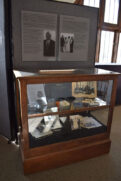
Most of the items on display in the newest exhibit at the Belen Harvey House Museum include items donated by George Clark’s nephew, Carl Rudolph.
“Through my research, I was able to find pictures of his parents and other family members online that Carl had never seen before,” Zeller said. “It took me a long time to do this because I immersed myself in it.”
Zeller wanted to take the time to do it right, and that both George Clark and Carl Rudolph deserved her undivided attention — one of the perks of having more time on her hands because of the pandemic.
Currently, the Belen Harvey House Museum is closed to the public, but when it does reopen, visitors must call ahead for an appointment.
“My hope is that people will see the exhibit online, and then hopefully, one day, be able to come and see it in person,” Zeller said. “George was a remarkable man who anybody would want to meet — and this is the next best thing.”
Clara Garcia is the editor and publisher of the Valencia County News-Bulletin.
She is a native of the city of Belen, beginning her journalism career at the News-Bulletin in 1998 as the crime and courts reporter. During her time at the paper, Clara has won numerous awards for her writing, photography and typography and design both from the National Newspaper Association and the New Mexico Press Association.
